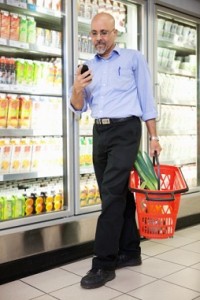Report from the front on the ever-changing landscape of retail payment habits.

Bricks and mortar retailers, long aware of how their customers have been using their smartphones in stores, are turning the tables and bringing more of their stores into our phones.
In the first of a new series, Digiday looks at how Sephora, Sears, Walmart, Target, Ikea, Home Depot and others “are fighting back against the Amazons of the world.”
The article quotes a study conducted by Xtreme Labs that found 58 percent of smartphone owners use them for store-related shopping, and are 14 percent are more likely to decide to purchase in-store than non-smartphone users.
Brian Monahan, Vice President of Marketing at Walmart, sees digital as another way to grab customers’ attention, adding, “A good digital in-store experience has many of the same attributes of any good retail experience — it is personalized, helps you quickly navigate, and saves you money.”
Walmart is currently testing their “Scan & Go” digital product, which uses location-based optimization to help shoppers make their way around any Walmart store they may step into, and then allows customers to use their smartphones to self-checkout.
Sears’ mobile app, SHOPSears, enhances shopping at stores with features such as e-coupons, mobile checkout and texting one’s parking spot so purchases may be brought to the car. In 2012, SHOPSears processed over 1.5 million transactions totaling more than $550 million in in-store sales according to Imran Jooma, Executive Vice President for Marketing, Online and Financial Services at Sears. “Customers have changed the way they shop,” says Jooma. “As retailers, we must change the way we sell.”
Other typical features of in-store apps include shopping history, location-specific deals, inventory checks and product reviews via scanned barcodes.
“The most successful digital in-store experiences are often the simplest ones, like in-store digital signage or digital experiences that get the customers to actually touch products,” according to John Jones, Senior Vice President at R/GA.
Jones cautions, however, that launching apps just to have them is a mistake. “Some retailers that shouldn’t be doing self-checkout are doing self-checkout. A big mistake is not thinking about the products and where the customers fit in to the digital experience.”
For small businesses, it probably doesn’t make sense to develop mobile web applications. However, a robust POS system can help provide consumers a customized experience, which may include faster and more accurate order processing, promotions tracking, and maintaining customer histories and preferences to streamline shopping and provide optimal service.
Additional benefits of the right POS system for small businesses include the ability to detect inventory “shrink,” process and track markdowns and promotions, maintain consistent prices among locations, maintain control when away from the store(s) and increase workforce efficiency.
A flexible, robust POS system from Sintel can connect with the e-commerce component of an online store, process orders and track inventory. Can your current POS system answer the call? If not, call Sintel Systems today.
Read the full Digiday post here.
Sintel Systems is the only full-service provider of tailored Point of Sale systems across retail, restaurant and service industries, including frozen yogurt shops, pizzerias, sushi restaurants, cafés and retail stores.
As a single source for business solutions, our experienced, knowledgeable team negotiates the complex POS landscape for you to enable you to find the right POS system for your business and budget. Hardware – Software – Support
Questions or Comments: Contact us 855-POS-SALES www.SintelSystems.com

